Fire and Rebirth: The Unbeatable French Spirit
By Michele Reed
michele@cny55.com
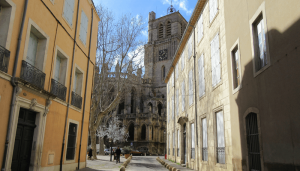
We were in Oswego when Notre Dame de Paris burned in April of this year. Watching on TV as the spire came crashing down, we could just imagine the reactions of our French friends and neighbors. Even though we live in the South of France, about as far away from Paris as you can be and still be in France, the capital and its cathedral are potent symbols for all French people.
One thing we’ve learned in our years in France is that the French value their patrimoine, or architectural heritage, in ways it is hard for we Americans to comprehend. Here, a building is considered ancient if it is 200 years old. There, it would be considered nothing remarkable.
For example, the stone foundations of our French home date back a thousand years, although it has been renovated and modernized over the years, most recently less than a decade ago. Two doors down the street from us, a house bears a shield with the year 1765 carved into it.
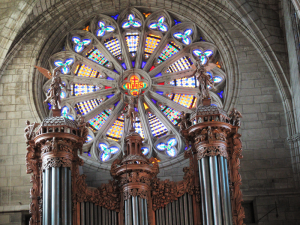
Public buildings in Europe are never “finished,” always a work in progress. Our village church was first built in the 6th century, with a square Roman tower. It was added to in the Middle Ages; and finally finished in the 19th century, with the vignerons, or prosperous winegrowers, donating huge sums to have it renovated, including mosaics by a famous Russian artist of the time.
This fact of European life — that churches, cathedrals and even houses continue to grow and evolve over centuries, including rebuilding when destroyed by war or fire — came home to us again, while watching the coverage of the Notre Dame fire. French President Emmanuel Macron promised Notre Dame would be repaired within five years. Scores of wealthy donors pledged billions of dollars to its restoration. We were happy to learn that a French lottery ticket we purchased went into a fund which will be used to restore Notre Dame, among other treasures of French heritage.
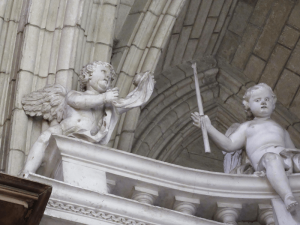
One article in our local French newspaper explained that the last time Notre Dame burned, during the French Revolution of 1789, the people harvested oak trees from the forests surrounding the Palace of Versailles to replace the wooden framework of the steeple. They immediately replanted those trees. Since then, for more than 200 years, an army of foresters has been bending and shaping the oak trees to the perfect curve for the underpinnings of the steeple. That’s planning ahead.
Much closer to home, our adopted French city of Beziers, about a 10-minute bus ride from our village, provides a great example of this rebirth in the face of adversity. Beziers’ Cathedral of Saint Nazaire and Saint Celse, was a Christian religious site from the 8th century, built atop the ruins of a Roman pagan temple.
It sits high on a hill, overlooking the whole valley of the Orb River, a strategic point to deter any possible enemies. The cathedral was built in the 10th century, added to and improved in the 12th century, but in 1209, it was destroyed by fire.
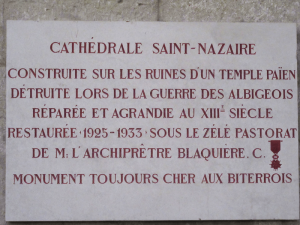
The attack on July 22, 1209, became known as the Massacre of Beziers. It was the first major military action of the Albigensian Crusade, mounted by the Catholic Church to root out and destroy the Cathar heresy, which had taken hold in the South of France. The Cathars were particularly strong in the area where we live.
When the Crusaders attacked the city of Beziers, thousands of people sought sanctuary in the cathedral and also the nearby churches of St. Jude and St. Mary Magdalene, where we attend mass on a regular basis. The medieval convention was that you could not be attacked if you found sanctuary in a holy place.
Thousands of faithful Catholics and Cathars alike were taking refuge, side by side, in the churches. When asked to hand over the heretics, the people of Beziers refused to betray their neighbors. The crusaders asked the papal legate what to do. He famously declared, “Kill them all. God will know His own.”
So the Crusaders rushed into the churches and cathedral, killing all inside. Chronicles of the time tell us that 20,000 people perished in the city, with 7,000 of those in the Church of St. Mary Magdelene.
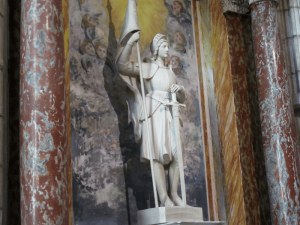
The Crusaders then set fire to the city. The cathedral burned and collapsed upon itself.
With the tenacity the French have always shown, the people of Beziers rebuilt the cathedral, starting in 1215 and continuing to the 15th century. The resulting structure is in the Gothic style, although the original Romanesque tower remains to this day. The most recent renovation dates from 1925 to 1933.
Today the Cathedral of Saint Nazaire in Beziers is a beautiful house of worship, made stronger by its history of rising — literally — above the ashes of its violent past.
We can all hope that President Macron, the French people, and lovers of Notre Dame from around the world, can make the same magic happen and restore Paris’ great landmark to its full glory soon.

